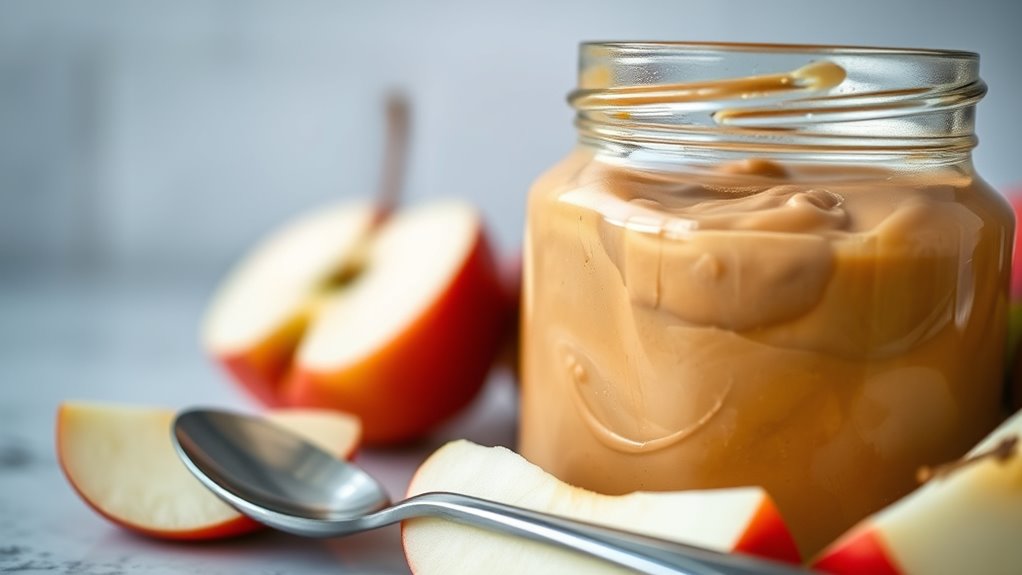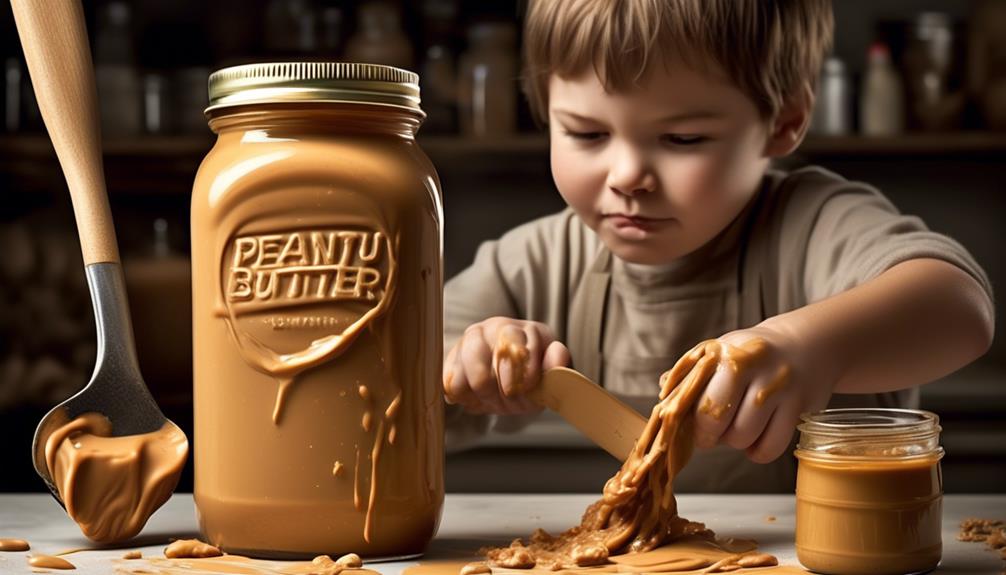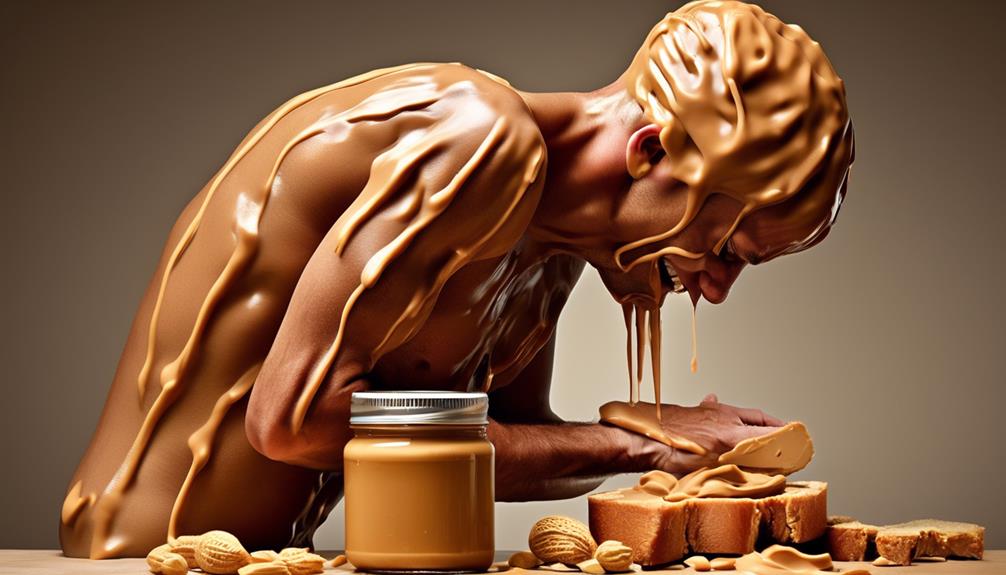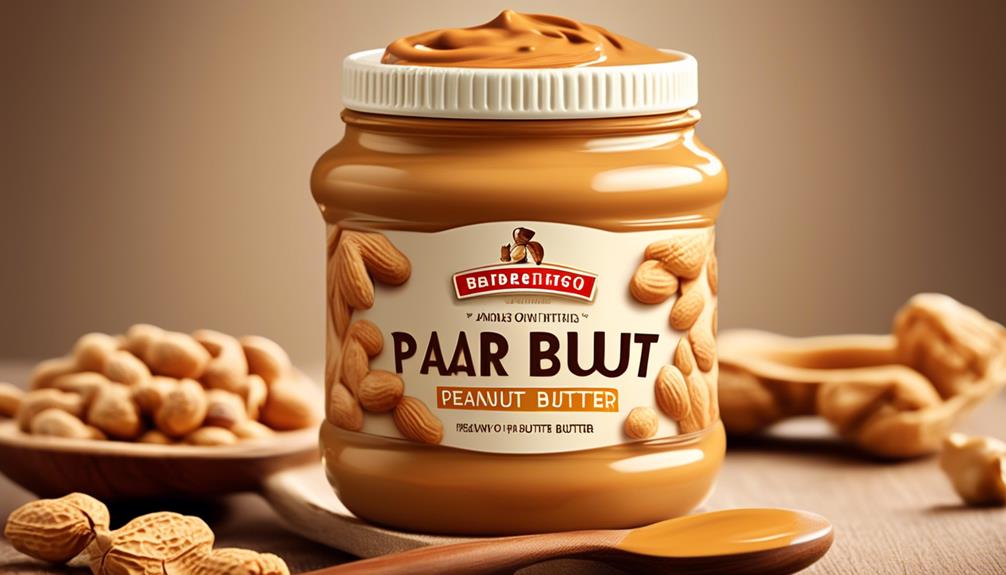To keep your peanut butter fresh longer, store it in airtight containers and keep it in a cool, dark place away from heat and light, which speed up oxidation. Consider refrigerating natural varieties after opening and using natural preservatives like vitamin E to slow spoilage. Avoid exposing it to air and temperature fluctuations, and always check for signs of rancidity or mold. If you want to learn more about preserving your peanut butter’s flavor and nutrition, keep exploring these tips.
Key Takeaways
- Store peanut butter in airtight, non-reactive containers to minimize air exposure and slow oxidation.
- Keep it in a cool, dark place or refrigerate to reduce heat and light that accelerate spoilage.
- Choose natural or minimally processed varieties with minimal additives for longer freshness.
- Add natural antioxidants like vitamin E to extend shelf life and prevent rancidity.
- Monitor for signs of spoilage, such as off smells or mold, and discard immediately if detected.
Understanding the Process of Oxidation in Peanut Butter
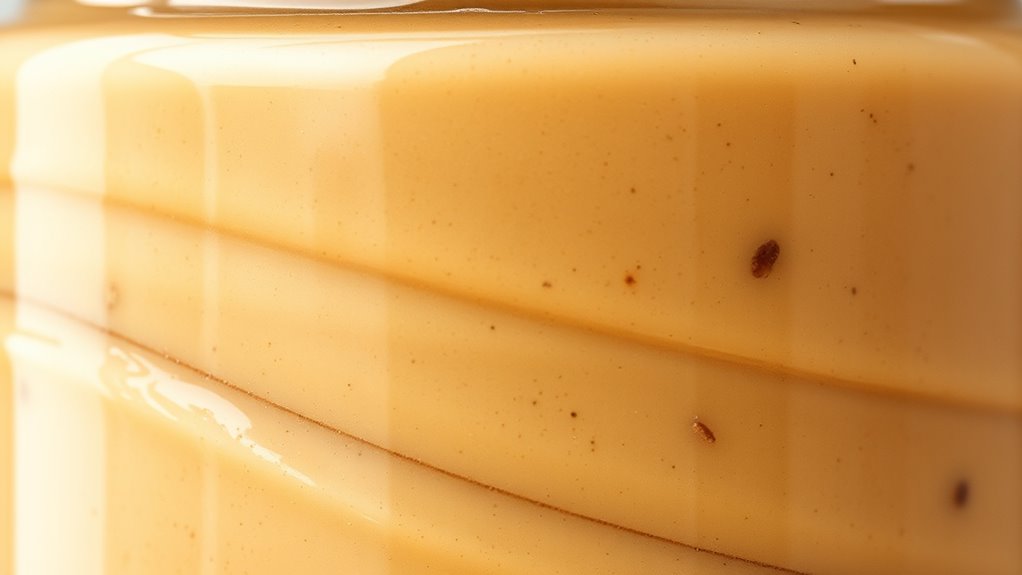
Oxidation occurs when the fats in peanut butter react with oxygen in the air, leading to changes in flavor, aroma, and nutritional quality. As this process begins, you might notice a decline in the nutty aroma that makes fresh peanut butter appealing. Over time, oxidation causes the oils to separate, resulting in visible oil pooling at the top or around the edges of the jar. This oil separation is a sign that fats are breaking down, which can accelerate spoilage. When exposed to air, heat, and light, the oxidation process speeds up, making your peanut butter less flavorful and less nutritious. Understanding how these reactions start helps you take steps to slow oxidation and keep your peanut butter fresher longer. Additionally, choosing quality ingredients and formulations can help reduce the rate of oxidation and preserve freshness.
The Impact of Oxidation on Flavor and Nutritional Value

As fats in peanut butter react with oxygen, the resulting oxidation process considerably alters its flavor and nutritional profile. You’ll notice a decline in freshness, as flavor deterioration causes it to taste rancid or bitter over time. This process also leads to nutritional degradation, reducing the levels of healthy fats, vitamins, and antioxidants that make peanut butter beneficial. The longer oxidation continues, the more you lose in both quality and health benefits. The changes can be subtle initially but become more pronounced, diminishing your enjoyment and the nutritional value you expect. To keep your peanut butter flavorful and nutritious, it’s essential to understand how oxidation impacts these qualities and take steps to prevent or slow down this process. Understanding oxidation and its effects on food can help you develop effective strategies for preventing spoilage and preserving nutritional integrity.
Choosing the Right Type of Peanut Butter for Longevity
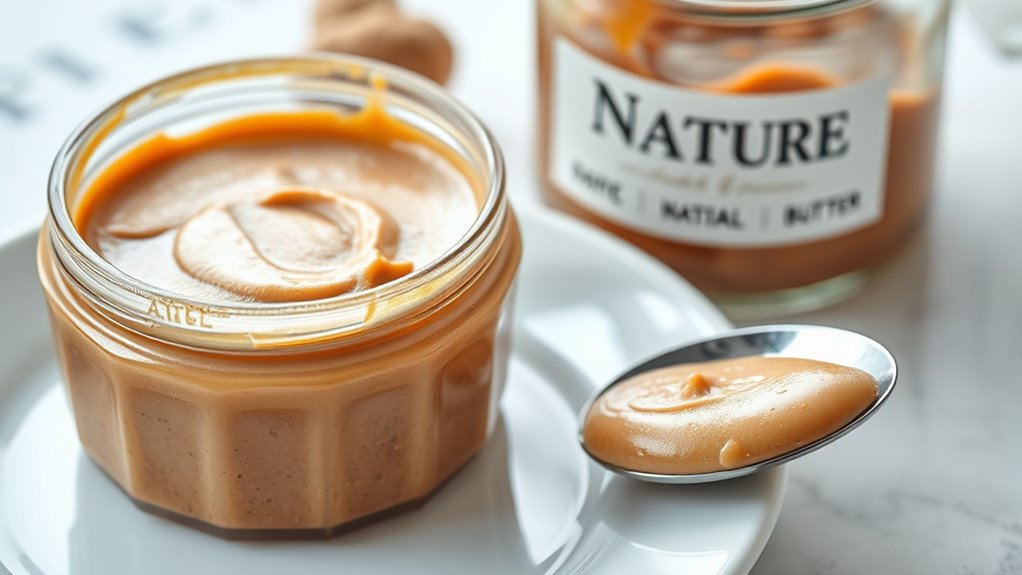
Choosing the right type of peanut butter can considerably extend its shelf life and preserve its flavor and nutrients. When selecting peanut butter varieties, opt for natural or minimally processed options, as they typically contain fewer preservatives and additives that may affect freshness. Check ingredient labels carefully—preferably, they should list only peanuts and a bit of salt. Avoid varieties with added sugars, hydrogenated oils, or artificial ingredients, as these can accelerate spoilage and oxidation. Natural peanut butters tend to have a shorter shelf life but stay fresher longer when stored properly. Additionally, understanding storage conditions can significantly impact peanut butter’s longevity and quality. By choosing a straightforward product with clear, simple ingredients, you reduce the risk of hidden preservatives that could compromise longevity, helping your peanut butter stay fresh and tasty for as long as possible.
Proper Storage Techniques to Preserve Freshness
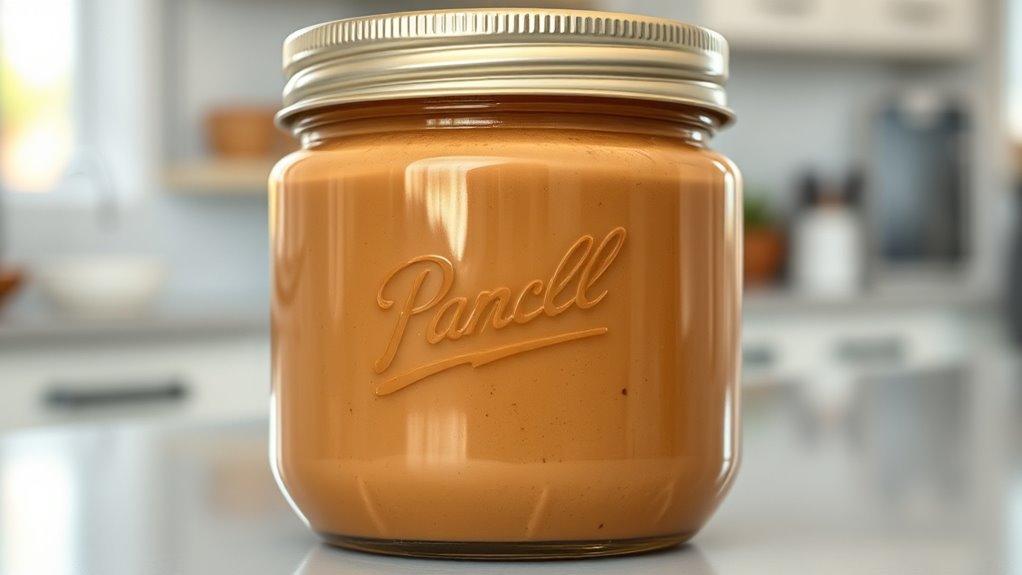
To keep your peanut butter fresh for as long as possible, proper storage techniques are essential. Store it in a cool, dark place, away from direct sunlight, to slow oxidation. If you or someone else has nut allergies, ensure the jar is tightly sealed to prevent cross-contamination. For homemade or natural peanut butter, refrigerate after opening to maintain freshness, especially if you use it in peanut butter recipes. Use the following table to choose the best storage method:
| Storage Location | Benefits | Notes |
|---|---|---|
| Pantry | Convenient, preserves flavor | Keep away from heat & sunlight |
| Refrigerator | Extends shelf life, prevents spoilage | May cause texture change |
| Airtight Container | Prevents oxidation | Essential for nut allergy safety |
| Cool, Dark Closet | Maintains freshness | Ideal if fridge isn’t available |
| Original Jar | Easy, familiar | Make certain lid is tight |
Additionally, minimizing exposure to oxygen can significantly extend the shelf life of your peanut butter.
The Importance of Airtight Containers and Sealing Methods
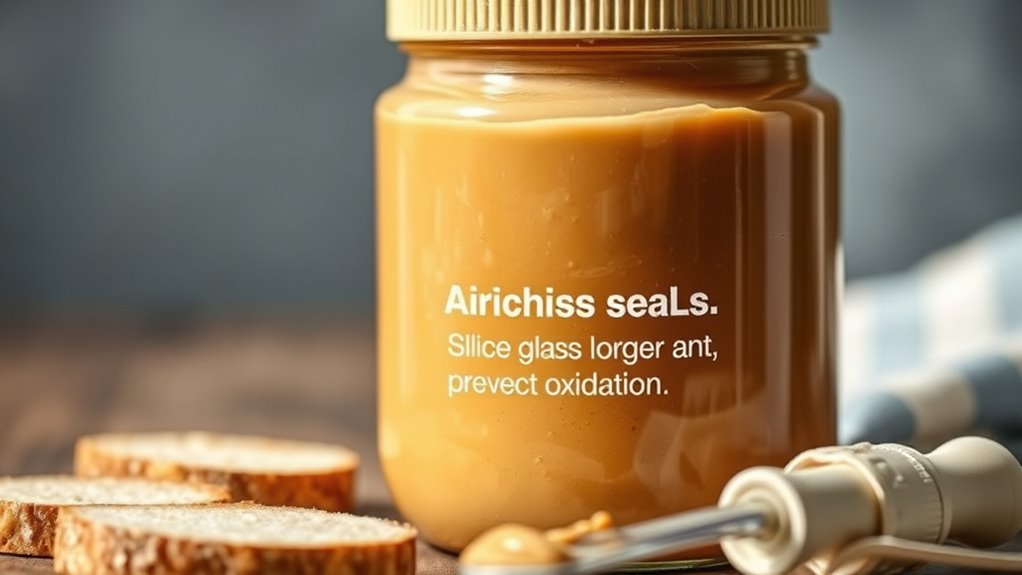
Using airtight containers and proper sealing methods keeps oxygen out, slowing down peanut butter oxidation. Choosing the right container and sealing it correctly are key to maintaining freshness longer. Tips on sealing techniques can help you preserve your peanut butter’s flavor and quality effectively. Additionally, selecting containers that are compliant with necessary cookies can ensure your storage method supports optimal freshness without compromising your privacy.
Air-Tight Seal Benefits
An airtight seal plays a crucial role in preserving peanut butter’s freshness by preventing exposure to air, moisture, and contaminants. This helps slow oxidation, keeping flavors vibrant and preventing spoilage. When storing peanut butter, a proper seal maintains its creamy texture, making it easier to use in various recipes. An airtight container also preserves the quality of your peanut butter for longer periods, so you won’t need to worry about rancidity. Additionally, a good seal supports better spreading techniques, ensuring your peanut butter remains smooth and easy to apply. Using appropriate storage containers designed for airtight sealing can further enhance the longevity of your peanut butter. If you’re making peanut butter recipes or just enjoying a snack, maintaining an airtight seal ensures that every spoonful stays fresh, flavorful, and ready to enhance your culinary creations.
Proper Container Choices
Choosing the right container is essential for maintaining peanut butter’s freshness and preventing oxidation. Opt for containers made from non-reactive materials like glass or high-quality plastic, as they won’t degrade or transfer odors. Metal containers can sometimes cause reactions that accelerate spoilage, so they’re less ideal. The container’s material should also support your desired storage duration; for short-term use, a simple airtight plastic jar works well. For longer storage, glass containers with tight-fitting lids provide a better barrier against air and moisture. Ensure the container seals completely to keep out oxygen, which is key to slowing oxidation. Color accuracy and the overall image quality can be preserved better with proper storage, which includes using suitable containers. Proper container choices help preserve flavor, texture, and freshness, giving you longer-lasting peanut butter with fewer worries about rancidity.
Sealing Technique Tips
Proper container choices set the foundation for keeping peanut butter fresh, but sealing techniques take it a step further by blocking out air that causes oxidation. To maximize freshness, guarantee your container is airtight—this prevents exposure to oxygen that leads to rancidity. When storing homemade peanut butter recipes, double-check seals or use vacuum-sealing bags for extra protection. Keep in mind peanut allergy awareness by avoiding cross-contamination, especially if sharing containers. After each use, wipe the rim and reseal tightly to maintain freshness. Proper sealing not only preserves flavor but also minimizes the risk of allergens spreading. For added security, consider transferring homemade peanut butter into smaller portions, sealing each separately, to limit exposure and extend shelf life. Additionally, understanding IRA investing strategies can help you plan your long-term savings more effectively.
How Temperature Affects the Oxidation Process
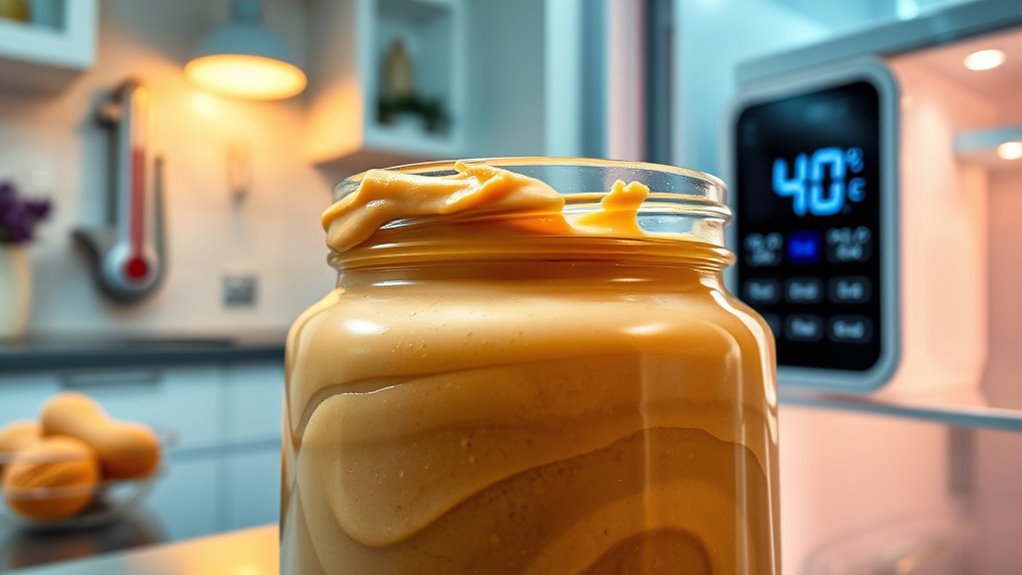
Temperature plays a crucial role in the oxidation of peanut butter, with higher temperatures accelerating the process. When you fail to maintain proper temperature control, the oxidation rate speeds up, causing rancidity and flavor loss. To preserve freshness, keep your peanut butter in a cool, stable environment. Avoid storing it near heat sources or in warm places. As shown below, temperature fluctuations can evoke feelings of frustration and waste:
| Temperature Range | Effect on Oxidation Rate | Emotional Impact |
|---|---|---|
| Below 50°F | Slows down oxidation | Peace of mind |
| 50-68°F | Moderate oxidation | Confidence in freshness |
| 68-77°F | Accelerates oxidation | Anxiety over spoilage |
| Above 77°F | Rapid oxidation | Urgency to consume quickly |
Controlling temperature helps you keep your peanut butter fresh longer and enjoy its flavor fully. Proper storage practices, including consistent temperatures, are essential to minimize oxidation processes and extend shelf life.
Natural Additives and Preservatives to Extend Shelf Life

Natural additives and preservatives offer a healthier way to extend the shelf life of peanut butter without relying on artificial chemicals. By incorporating natural preservatives, you can slow down oxidation and keep your peanut butter fresh longer. These include antioxidant additives that combat free radicals, preventing rancidity. You might consider adding ingredients like vitamin E (tocopherols), rosemary extract, or tocopherol-rich oils, which naturally preserve freshness. These options not only enhance shelf stability but also maintain the product’s natural qualities. Using natural preservatives allows you to avoid synthetic chemicals while extending the peanut butter’s lifespan. Incorporating dog names or other culturally meaningful names into your storage routine can also add a personal touch to your kitchen decor, making the process more enjoyable. Incorporate these antioxidant additives into your storage routine to improve longevity and preserve flavor without compromising health benefits.
Tips for Recognizing Signs of Spoilage and When to Discard
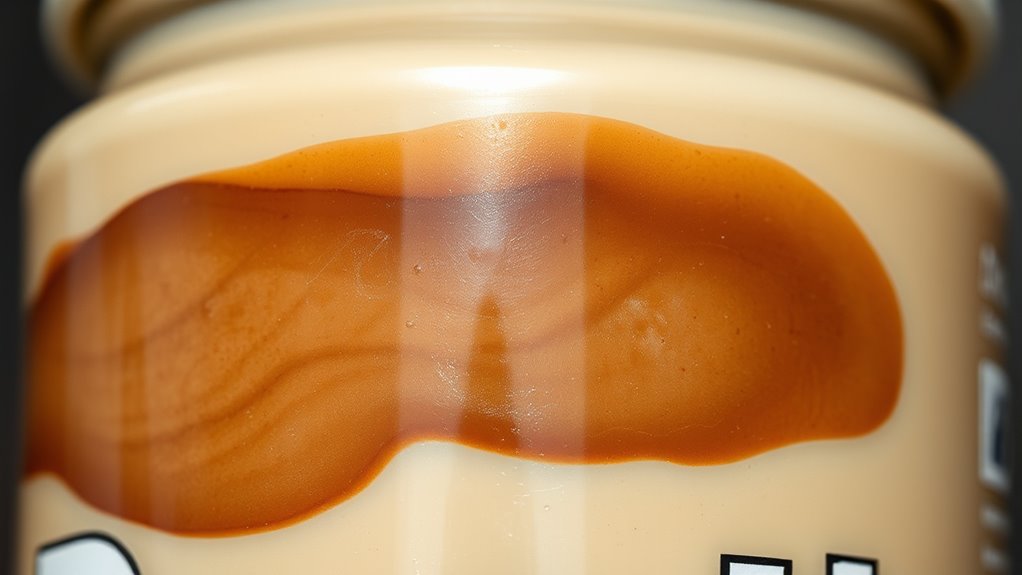
Knowing how to spot spoilage in peanut butter is essential to guarantee safety and quality. Look for changes like an off smell, mold, or a rancid taste. If the texture becomes excessively oily or sticky, it might be a sign of oxidation. Always check for discoloration, which can indicate spoilage or mold growth. For those with nut allergy implications, discard immediately if any signs appear. Proper homemade preservation methods, like airtight containers and refrigeration, can extend shelf life, but spoilage can still occur. Use the table below to identify warning signs and when to discard:
| Sign of Spoilage | When to Discard |
|---|---|
| Mold or visible growth | Immediately, discard and clean container |
| Unpleasant odor | Discard if smell persists after stirring |
| Rancid taste | Discard to avoid health risks |
Frequently Asked Questions
Can Refrigeration Slow Down Peanut Butter Oxidation Effectively?
Refrigeration benefits include slowing down oxidation in peanut butter, helping it stay fresh longer. When you refrigerate, you reduce the exposure to heat and oxygen, which are key factors in oxidation. Proper storage techniques, like sealing the jar tightly and keeping it in the fridge, can substantially extend its shelf life. So, yes, refrigeration effectively slows down peanut butter oxidation, preserving flavor and texture over time.
Does Stirring Peanut Butter Help Reduce Oxidation Levels?
Coincidentally, stirring your peanut butter can help redistribute oils and potentially slow oxidation. Using effective stirring techniques guarantees even oil distribution, which can improve texture and freshness. When you stir, you’re mixing the oxidized surface with the fresher interior, reducing overall oxidation levels. This simple action not only maintains flavor but also helps extend shelf life by preventing oil separation and exposing less surface area to oxygen.
Are Homemade Preservatives Safe for Extending Peanut Butter Shelf Life?
You might wonder if homemade preservatives are safe for extending peanut butter’s shelf life. Natural preservatives, like honey or vinegar, are generally safe when used properly. However, artificial additives can pose health risks if overused. Always prioritize safe, food-grade ingredients and follow trusted recipes. Using natural preservatives helps keep your peanut butter fresh longer without compromising safety, while avoiding unnecessary artificial additives.
How Does Exposure to Light Accelerate Peanut Butter Spoilage?
Did you know that light exposure can speed up peanut butter spoilage by breaking down fats and oils? When your jar sits in direct sunlight, it accelerates shelf degradation, leading to rancidity and loss of flavor. To keep your peanut butter fresh longer, store it in a cool, dark place. This simple step prevents light-induced oxidation, ensuring it stays tasty and safe to enjoy for a longer time.
Is Natural Oil Separation an Indicator of Oxidation Progress?
You might notice natural oil separation in your peanut butter, and yes, it can be a visual cue of oxidation progress. When the natural oil rises to the surface, it indicates the oils are breaking down over time. While this isn’t a definitive sign of spoilage, it suggests the peanut butter’s freshness is declining. To keep it fresh longer, stir the oil back in or store it in a cool, dark place.
Conclusion
By understanding how oxidation affects peanut butter, you can better preserve its freshness. Using airtight containers and storing it at the right temperature naturally coincides with choosing the best type of peanut butter for longevity. When you pay attention to signs of spoilage, you’ll notice that keeping your peanut butter fresh isn’t just about luck—it’s about making smart, timely choices. Sometimes, the smallest details make all the difference in enjoying it longer.
